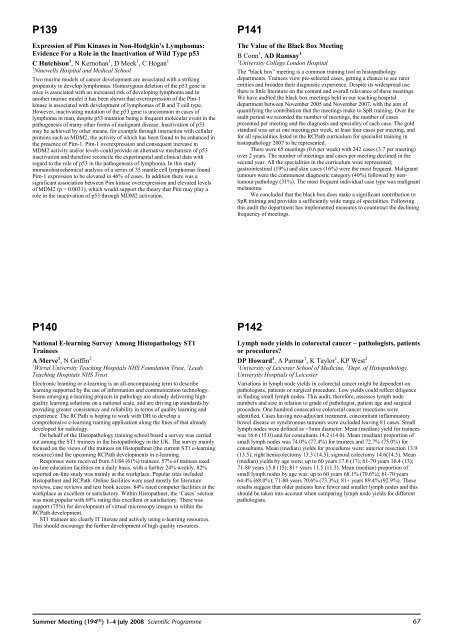2008 Summer Meeting - Leeds - The Pathological Society of Great ...
2008 Summer Meeting - Leeds - The Pathological Society of Great ...
2008 Summer Meeting - Leeds - The Pathological Society of Great ...
Create successful ePaper yourself
Turn your PDF publications into a flip-book with our unique Google optimized e-Paper software.
P139Expression <strong>of</strong> Pim Kinases in Non-Hodgkin’s Lymphomas:Evidence For a Role in the Inactivation <strong>of</strong> Wild Type p53C Hutchison 1 , N Kernohan 1 , D Meek 1 ,CHogan 11 Ninewells Hospital and Medical SchoolTwo murine models <strong>of</strong> cancer development are associated with a strikingpropensity to develop lymphomas. Homozygous deletion <strong>of</strong> the p53 gene inmice is associated with an increased risk <strong>of</strong> developing lymphoma and inanother murine model it has been shown that overexpression <strong>of</strong> the Pim-1kinase is associated with development <strong>of</strong> lymphomas <strong>of</strong> B and T cell type.However, inactivating mutation <strong>of</strong> the p53 gene is uncommon in cases <strong>of</strong>lymphoma in man, despite p53 mutation being a frequent molecular event in thepathogenesis <strong>of</strong> many other forms <strong>of</strong> malignant disease. Inactivation <strong>of</strong> p53may be achieved by other means, for example through interaction with cellularproteins such as MDM2, the activity <strong>of</strong> which has been found to be enhanced inthe presence <strong>of</strong> Pim-1. Pim-1 overexpression and consequent increase inMDM2 activity and/or levels could provide an alternative mechanism <strong>of</strong> p53inactivation and therefore reconcile the experimental and clinical data withregard to the role <strong>of</strong> p53 in the pathogenesis <strong>of</strong> lymphoma. In this studyimmunohistochemical analysis <strong>of</strong> a series <strong>of</strong> 35 mantle cell lymphomas foundPim-1 expression to be elevated in 46% <strong>of</strong> cases. In addition there was asignificant association between Pim kinase overexpression and elevated levels<strong>of</strong> MDM2 (p = 0.0031), which would support the theory that Pim may play arole in the inactivation <strong>of</strong> p53 through MDM2 activation.P141<strong>The</strong> Value <strong>of</strong> the Black Box <strong>Meeting</strong>BConn 1 , AD Ramsay 11 University College London Hospital<strong>The</strong> “black box” meeting is a common training tool in histopathologydepartments. Trainees view pre-selected cases, getting a chance to see rarerentities and broaden their diagnostic experience. Despite its widespread usethere is little literature on the content and overall relevance <strong>of</strong> these meetings.We have audited the black box meetings held in our teaching hospitaldepartment between November 2005 and November 2007, with the aim <strong>of</strong>quantifying the contribution that the meetings make to SpR training. Over theaudit period we recorded the number <strong>of</strong> meetings, the number <strong>of</strong> casespresented per meeting and the diagnosis and speciality <strong>of</strong> each case. <strong>The</strong> goldstandard was set at one meeting per week, at least four cases per meeting, andfor all specialities listed in the RCPath curriculum for specialist training inhistopathology 2007 to be represented.<strong>The</strong>re were 65 meetings (0.6 per week) with 242 cases (3.7 per meeting)over 2 years. <strong>The</strong> number <strong>of</strong> meetings and cases per meeting declined in thesecond year. All the specialities in the curriculum were represented;gastrointestinal (19%) and skin cases (16%) were the most frequent. Malignanttumours were the commonest diagnostic category (40%) followed by nontumourpathology (31%). <strong>The</strong> most frequent individual case type was malignantmelanoma.We concluded that the black box does make a significant contribution toSpR training and provides a sufficiently wide range <strong>of</strong> specialities. Followingthis audit the department has implemented measures to counteract the decliningfrequency <strong>of</strong> meetings.P140National E-learning Survey Among Histopathology ST1TraineesAMerve 1 , N Griffin 21 Wirral University Teaching Hospitals NHS Foundation Trust, 2 <strong>Leeds</strong>Teaching Hospitals NHS TrustElectronic learning or e-learning is an all-encompassing term to describelearning supported by the use <strong>of</strong> information and communication technology.Some emerging e-learning projects in pathology are already delivering highqualitylearning solutions on a national scale, and are driving up standards byproviding greater consistency and reliability in terms <strong>of</strong> quality learning andexperience. <strong>The</strong> RCPath is hoping to work with DH to develop acomprehensive e-learning training application along the lines <strong>of</strong> that alreadydeveloped for radiology.On behalf <strong>of</strong> the Histopathology training school board a survey was carriedout among the ST1 trainees in the histopathology in the UK. <strong>The</strong> survey mainlyfocused on the views <strong>of</strong> the trainees on Histopathnet (the current ST1 e-learningresource) and the upcoming RCPath developments in e-learning.Responses were received from 51/84 (61%) trainees. 57% <strong>of</strong> trainees usedon-line education facilities on a daily basis, with a further 24% weekly. 82%reported on-line study was mainly at the workplace. Popular sites includedHistopathnet and RCPath. Online facilities were used mostly for literaturereviews, case reviews and text book access. 84% rated computer facilities at theworkplace as excellent or satisfactory. Within Histopathnet, the ‘Cases’ sectionwas most popular with 69% rating this excellent or satisfactory. <strong>The</strong>re wassupport (75%) for development <strong>of</strong> virtual microscopy images to within theRCPath development.ST1 trainees are clearly IT literate and actively using e-learning resources.This should encourage the further development <strong>of</strong> high quality resources.P142Lymph node yields in colorectal cancer – pathologists, patientsor procedures?DP Howard 1 , A Parmar 1 ,KTaylor 1 ,KP West 21 University <strong>of</strong> Leicester School <strong>of</strong> Medicine, 2 Dept. <strong>of</strong> Histopathology,University Hospitals <strong>of</strong> LeicesterVariations in lymph node yields in colorectal cancer might be dependent onpathologists, patients or surgical procedure. Low yields could reflect diligencein finding small lymph nodes. This audit, therefore, assesses lymph nodenumbers and size in relation to grade <strong>of</strong> pathologist, patient age and surgicalprocedure. One hundred consecutive colorectal cancer resections wereidentified. Cases having neo-adjuvant treatment, concomitant inflammatorybowel disease or synchronous tumours were excluded leaving 81 cases. Smalllymph nodes were defined as













